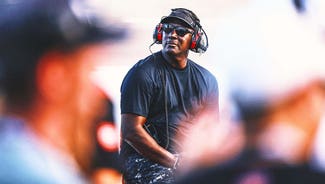
NASCAR finally gets Chase happy ending
On Sunday, Texas Motor Speedway was the site of one of the more memorable NASCAR Sprint Cup races in recent history.
The AAA Texas 500 featured everything from a fight — on live national television — between two of the sport's more demure drivers (Jeff Gordon and Jeff Burton) to a surprising (some would say questionable) decision by the top crew chief in the sport (Chad Knaus) to replace his entire pit crew in the middle of the race, an obscene gesture by one of the sport’s maverick drivers (perhaps predictable behavior on the part of Kyle Busch, but entertaining nonetheless) and a wild finish netting a new points leader (Denny Hamlin) with just two races remaining in the season.
Oh, yeah. For good measure, Hamlin’s victory placed another obstacle on the increasingly difficult path being taken by defending series champion Jimmie Johnson in his quest for an unprecedented fifth consecutive title.
In other words? Everything NASCAR was hoping for when it revamped its championship format seven years ago — and everything the slumping league needs as it looks to rekindle interest in the sport.
At the end of the 2003 season, after Matt Kenseth led the points standings for most of the year and won the title despite a one-victory campaign, some were demanding changes be made in the way in which the championship was determined.
NASCAR officials responded with the Chase for the Sprint Cup. The idea was to pit the top 10 drivers in points at the end of 26 races against each other while racing within the field of 43 cars over the final 10 races. The format was met with mixed reactions and set off a firestorm of discontent within the sport's longtime, Southern fan base.
Then, at the beginning of the 2007 season, in what most observers say was a reaction to the sport’s most popular driver, Dale Earnhardt Jr., ending the season just outside the top 10, the field of qualifiers was expanded to 12.
While 10 races is a long time, it quickly became apparent to drivers and crew chiefs that in order to win the championship, your team had to be the one that made the least amount of mistakes. It meant running 10 error-free races.
Initially, this was the strategy that teams took into the Chase, until Jimmie Johnson’s Hendrick Motorsports team disproved the theory by winning championships even after having more than one “bad” race during the Chase.
Johnson’s crew chief, Knaus, set a new plan: His team was going to focus on the 10 tracks in the Chase and make sure those became the team’s 10 best.
It was the key component to the No. 48 team's winning strategy, and it propelled Johnson and Knaus to a record four straight Sprint Cup titles (2006 through 2009).
That run has been viewed as detrimental by some critics. Now, NASCAR officials face a similar situation as in 2003, with fans up in arms about the championship and the media fueling the fire.
Now, though, Johnson’s streak is in danger. That fact, coupled with the type of racing that fans have seen in recent weeks, has revived the Chase and added much-needed life to this segment of the season.
Pressure is building. Hendrick Motorsports has given Johnson teammate Jeff Gordon’s pit crew. RCR made a similar move earlier, moving Clint Bowyer’s group to his higher-in-the-standings teammate Kevin Harvick. Crew chiefs are playing mind games with pit stall selection. Tensions are so high, the normally mild-mannered Gordon and Burton had the meltdown at Texas.
And now we've got a new face atop the standings.
All of this makes the Chase more lively, more exciting — and the next race more anticipated by fans.
As the series leaves Texas and heads next to Phoenix for the penultimate race before the finale in South Florida in two weeks, Johnson finds himself in an unfamiliar spot — second in points behind Hamlin with Harvick third.
All three have a mathematical shot at winning the title in the closest three-way race for the title in recent years.
Both Hamlin and Harvick’s teams are the equal of Johnson’s in all of the critical elements for success — detailed preparation, flawless execution and a desire to win. That last part is perhaps the most important, as it represents the greatest variable because it only grows stronger with every successful race weekend.
A championship for Hamlin would be a storybook ending to his best season ever in NASCAR, one that began with his needing knee surgery early in the year, but was quickly followed by a dogged determination not to let it slow him down.
It never did.
Harvick, meanwhile, has won the Daytona 500 (2008) as well as NASCAR’s Triple-A series crown, the Nationwide Series, twice. But those accomplishments would pale in comparison to a Sprint Cup title. A championship for Harvick would also mark the completion of a comeback for Richard Childress Racing, which hasn’t won a Sprint Cup title since the legendary Dale Earnhardt Sr. won it back to back in 1993 and ’94.
And then there's Johnson, who's been somewhat taken for granted, even as he was winning four straight Cup crowns.
If he's to make it five in a row, however, he's going to have to do it in a manner unlike any of the previous four — coming from behind in the final two races. Given that no one's done that in the seven-year history of the Chase, it'd be awfully difficult to take that accomplishment for granted.
Regardless of what happens down the stretch, the 2010 Chase has delivered on a promise of down-to-the-wire excitement and has given the fans and sponsors the kind of championship run they have been asking for.
In two weeks, NASCAR looks to either crown a first-time champion or rewrite the record books. Either way, the fans are the real winners here.

